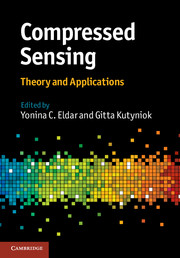Book contents
- Frontmatter
- Contents
- List of contributors
- Preface
- 1 Introduction to compressed sensing
- 2 Second-generation sparse modeling: structured and collaborative signal analysis
- 3 Xampling: compressed sensing of analog signals
- 4 Sampling at the rate of innovation: theory and applications
- 5 Introduction to the non-asymptotic analysis of random matrices
- 6 Adaptive sensing for sparse recovery
- 7 Fundamental thresholds in compressed sensing: a high-dimensional geometry approach
- 8 Greedy algorithms for compressed sensing
- 9 Graphical models concepts in compressed sensing
- 10 Finding needles in compressed haystacks
- 11 Data separation by sparse representations
- 12 Face recognition by sparse representation
- Index
3 - Xampling: compressed sensing of analog signals
Published online by Cambridge University Press: 05 November 2012
- Frontmatter
- Contents
- List of contributors
- Preface
- 1 Introduction to compressed sensing
- 2 Second-generation sparse modeling: structured and collaborative signal analysis
- 3 Xampling: compressed sensing of analog signals
- 4 Sampling at the rate of innovation: theory and applications
- 5 Introduction to the non-asymptotic analysis of random matrices
- 6 Adaptive sensing for sparse recovery
- 7 Fundamental thresholds in compressed sensing: a high-dimensional geometry approach
- 8 Greedy algorithms for compressed sensing
- 9 Graphical models concepts in compressed sensing
- 10 Finding needles in compressed haystacks
- 11 Data separation by sparse representations
- 12 Face recognition by sparse representation
- Index
Summary
This chapter generalizes compressed sensing (CS) to reduced-rate sampling of analog signals. It introduces Xampling, a unified framework for low-rate sampling and processing of signals lying in a union of subspaces. Xampling consists of two main blocks: analog compression that narrows down the input bandwidth prior to sampling with commercial devices followed by a nonlinear algorithm that detects the input subspace prior to conventional signal processing. A variety of analog CS applications are reviewed within the unified Xampling framework including a general filter-bank scheme for sparse shift-invariant spaces, periodic nonuniform sampling and modulated wideband conversion for multiband communications with unknown carrier frequencies, acquisition techniques for finite rate of innovation signals with applications to medical and radar imaging, and random demodulation of sparse harmonic tones. A hardware-oriented viewpoint is advocated throughout, addressing practical constraints and exemplifying hardware realizations where relevant.
Introduction
Analog-to-digital conversion (ADC) technology constantly advances along the route that was delineated in the last century by the celebrated Shannon–Nyquist [1, 2] theorem, essentially requiring the sampling rate to be at least twice the highest frequency in the signal. This basic principle underlies almost all digital signal processing (DSP) applications such as audio, video, radio receivers, wireless communications, radar applications, medical devices, optical systems and more. The ever growing demand for data, as well as advances in radio frequency (RF) technology, have promoted the use of high-bandwidth signals, for which the rates dictated by the Shannon–Nyquist theorem impose demanding challenges on the acquisition hardware and on the subsequent storage and DSP processors.
- Type
- Chapter
- Information
- Compressed SensingTheory and Applications, pp. 88 - 147Publisher: Cambridge University PressPrint publication year: 2012
- 10
- Cited by

